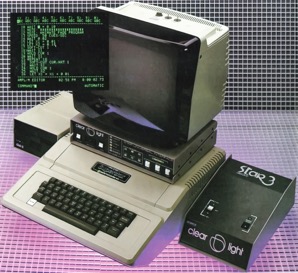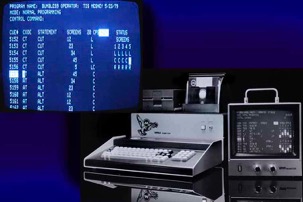A view of Lake Pend Oreille from the mountainside northwest of Sandpoint, and just west of the Airport. My home is just below this viewpoint.
Clear Light History 3
The Clear Light Superstar
More and More Microprocessors!
As we stated earlier, we ended up creating quite a number of masks for the Mostek 3870. We then created the Clear Light SuperStar from an Apple II computer, which included the Universal Interface. This device could interface between Star or Star Sentry Series dissolve units, the Apple computer, and a tape recorder When connected to the Apple II, it was the interface between the computer and the dissolves at up to 100 commands per second, but also could encode a digital Data Sentry signal on tape (or decode it) at 50 cues per second - the fastest in the industry. Data Sentry ensured a program always stayed in sync. If a cue was missed, it would correct the mistake automatically.
The Micro series was also created, using a different cabinet design to reduce manufacturing costs by having all the controls on one circuit board, thus reducing the labor in assembly, harness wiring, etc. during manufacturing. You can see photos from our 1981 brochures on the Clear Light Photos page.
The SuperStar: Which Computer to Use?
The SuperStar was a project with some interesting twists. We took our time selecting a suitable computer to use. All of the S-100 computers available, like the one AVL was using, were large boxes that were very heavy, had hundreds of components on multiple boards and a large power supply and fan, and were not great for shipping - too many things to break or shake lose. When I first saw an Apple // when visiting a friend (and got to play Brickout on it), I fell in love with the design. It was light, had a built-in keyboard, had a switching power supply for light weight, had a single motherboard and some small slots in the back for plug-ins. It was very rugged, and could handle static buildup without crashing.
The AVL Eagle, original version, in a very large S-100 cabinet, with a separate keyboard connected via ribbon cable. Very basic and simple programming, no Syncrolink! And ribbon cable was not designed for external runs. It is very easily zapped with static.
Click to enlarge
My AVL Eagle Story
The brings up another story: when visiting the AVL booth one year, to see how their Eagle Computer worked for programming an AV show, I was very nervous, and shifting my foot around on the rug. This ended up causing a spark between my finger and the keyboard, which crashed the Eagle.
Being audacious, I realized I could have some fun. So I called the sales guy over, and said "Did you know your computer has speech recognition?" He asked me what I was talking about. So I said "Watch!" I started moving my foot on the rug, with my hands on the keyboard. I spoke loudly and carefully: "Computer, CRASH!" And it did!
They shooed me out of the booth. The next show, I noticed they had installed static pads under every unit and on the floor, and were busy spraying anti-static spray everywhere. Oh, mean ol’ me, putting the fear of God into my competitors!
Developing the Multi-Tasking Advanced Multi-Image Programming Language (AMPL/M)
The first attempt to create the superstar was to hire a software development team. They wanted to use the Z80 processor, so we accepted the idea of a Z80 plug-in board for the Apple //. They worked and worked on a solution they claimed would be epic: it would not only provide a means to create the SuperStar, but would provide the ability to create many other programs. It was a "compiler compiler" - where you defined how the system you wanted would work with a set of logical statements.
I should have kicked these guys out - they kept losing their stuff when some static electricity would accidentally crash their 8" floppy drives. What? No backup? You guys say your are pros?
While they were working on that, I was programming a demo in assembly for the 6502 on the Apple //. It was quite spiffy, had exactly the user interface I wanted, and was lightning fast.
When they had their first demo, it was admittedly on 80 column screen rather than 40, but it was unbelievably slow. Embarrassedly slow. Unacceptably slow. And, there was no fixing it. There was too much compiler overhead. So, bye bye to their approach. We told them "Do it my way, in 6502 assembly, or you are finished." They accepted, and did actually do it.
The amazing thing: multitasking on a Apple //. This was absolutely earth shattering for our competitors. Rather than having to manually intermix commands from various independent things going on in a program, the computer did it for you in real time. And, you could SyncroLink any of the timelines separately!
I remember AVL trying to do the same thing. I saw their next generation system while it was still in development. When you got to the end of a line of programming, and hit the return key, the cursor hovered there for a couple of seconds, before returning to the beginning of the next line. I recognized the problem immediately. They were trying to program it in C, and at that time in history, the personal computers could not handle the overhead, and the result was up to 10x speed loss. I don’t think they ever did solve that problem before the end of slide projectors and the age of video overtook them. And us, for that matter. That’s a very good reason to exit stage left, to Apple.
But before I went, I was working on the SuperStar Dissolve. It had an interactive text display, and could do any of the various tricks known at the time, including virtually any dissolve rate you could imagine. It was designed to be the ultimate dissolve unit, expandable, with projector interface plug-in boards. It was never completed.

A short snippet of AMPL/M programming, showing the Start Task statement. The Apple II would be executing up to 4 simultaneous "time lines" of cues at the same time, with a maximum speed of 100 commands per second. However, the Apple could "scan" non-projector commands, such as Waits, Notes, Repeats, and similar control statements at over 1000 lines per second.
More on Clear Light
Be sure to check out our other Clear Light pages:
Previous Page
Copyright © 2017 Anderson Creations. All Rights Reserved.



